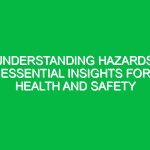Welcome to Our Toolbox Talk
Good morning, team! Today, we’re here to discuss a critical topic that impacts our Safety on the job: High Wind Dangers. As we all know, working in environments where wind can become a factor poses unique challenges and risks. By understanding these dangers, we can take proactive measures to protect ourselves and our colleagues. Let’s dive into what you need to know about working safely in windy conditions.
What Are High Wind Dangers?
High Wind Dangers refer to the Hazards associated with strong winds that can affect our Safety while working outdoors or on structures. High winds can lead to a range of accidents, from falling objects to compromised equipment stability, and can even impact our personal safety if we are not vigilant. Understanding these dangers is vital for our Health, Safety, and Environment (HSE) protocols.
Types of High Wind Dangers
Let’s break down some specific types of dangers associated with high winds:
- Flying Debris: High winds can turn loose objects into dangerous projectiles. Items like tools, equipment, and even construction materials can be lifted and thrown.
- Fall Hazards: Workers on scaffolding, ladders, or rooftops face an increased risk of falling if wind conditions are strong and unstable.
- Equipment Stability: Heavy machinery can become unstable in high winds, potentially leading to tipping or loss of control.
- Reduced Visibility: Wind can carry dust and debris, reducing visibility and creating additional hazards for workers.
- Structural Damage: High winds can cause damage to temporary structures, tarps, and scaffolding, which can lead to collapse.
The Importance of Recognizing High Wind Dangers
Recognizing High Wind Dangers is crucial for several reasons:
- **Preventing Accidents:** Awareness leads to better preparation and response to potential hazards.
- **Compliance with Regulations:** Many safety regulations require that we assess weather conditions and their impact on our work.
- **Enhancing Team Safety:** A culture of safety begins with informed employees who can look out for one another.
Real-Life Examples and Scenarios
Let’s consider a scenario to illustrate the impact of high winds on our operations. Imagine a construction site where workers are using scaffolding to complete a project. If a sudden gust of wind sweeps through the site, it could easily knock over unsecured tools, leading to injuries. Additionally, if workers are not properly secured, they could lose their balance and fall from heights.
In another example, think about a day when the wind picks up, and a tarp covering materials flaps violently. If workers do not secure the tarp or if they attempt to hold it down during high winds, they risk injury from the flapping tarp or from materials being blown away.
Best Practices for Working in High Winds
To mitigate the risks associated with High Wind Dangers, here are some Best Practices to keep in mind:
- Check Weather Conditions: Always begin your day by checking the weather forecast. If high winds are predicted, discuss the potential impacts with your supervisor.
- Secure Loose Items: Before starting work, ensure that all tools, equipment, and materials are secured to prevent them from becoming flying debris.
- Use Proper Equipment: Make sure that scaffolding, ladders, and other equipment are rated for high winds and are properly anchored.
- Establish Clear Communication: Use radios or hand signals to communicate with team members during windy conditions, ensuring that everyone is aware of the situation.
- Implement a Safety Plan: Develop a safety plan that includes protocols for high winds, including evacuation routes and safe zones.
- Educate and Train: Regularly conduct Training sessions focusing on high winds and how to respond to wind-related emergencies.
Regulations and Standards
In our industry, several regulations govern safety practices related to High Wind Dangers. These include:
- OSHA Regulations: The Occupational Safety and Health Administration (osha) mandates that employers provide a safe working environment, which extends to assessing weather conditions.
- Local Safety Codes: Many municipalities have specific codes regarding construction practices during adverse weather conditions.
- Company Policies: Review your company’s safety policies regarding high winds and adhere to the established protocols.
Compliance with these regulations is not just a legal obligation; it is a commitment to your safety and the safety of your coworkers.
Discussion and Engagement
Now that we have covered the essentials of High Wind Dangers, I would like to open the floor for discussion. Here are a few questions to consider:
- Have you ever encountered dangerous conditions due to high winds on the job? What happened?
- What additional Safety Measures do you think we could implement to improve our response to high wind conditions?
- How can we better communicate about changes in weather while on the job?
Your insights and experiences are invaluable, and discussing these topics helps us create a safer work environment.
Conclusion
In conclusion, understanding and recognizing High Wind Dangers is essential for ensuring our safety on the job. By implementing Best Practices, adhering to regulations, and maintaining open communication, we can significantly reduce the risks associated with high winds. Remember, safety is a shared responsibility, and each of us plays a critical role in maintaining a safe workplace.
Thank you for your attention and commitment to safety today. Let’s stay vigilant and look out for one another as we continue our work. Together, we can navigate any challenges that come our way!


